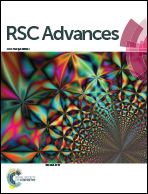NiO@MnO2 core–shell composite microtube arrays for high-performance lithium ion batteries†
Abstract
Tubular array structures are very attractive for electrochemical energy storage and conversion systems due to their unique physicochemical properties. Herein, a NiO microtube array is fabricated via a facile oxalic acid corrosion method followed by heat treatment. A NiO@MnO2 core–shell composite microtube array is further achieved by the anodic electrodeposition using the NiO microtube array as substrate. When applied as self-supported electrode for lithium ion batteries (LIBs), the NiO@MnO2 core–shell composite microtube array electrode shows excellent lithium storage properties. The electrode delivers a reversible capacity of 510 mA h g−1 at a high rate of 5.1 A g−1, showing its good rate capability. In particular, a reversible capacity of 1573 mA h g−1 is observed after 500 cycles at a current density of 0.53 A g−1, demonstrating the superior cycling performance of the electrode. The electrodeposited MnO2 layer as a protective shell prevents the NiO microtubes from deformation during electrochemical cycling, responsible for the superior cycle stability of the NiO@MnO2 core–shell composite microtube array electrode. The prominent lithium storage performance of the composite microtube array electrode can be attributed to its unique structure characteristics.



 Please wait while we load your content...
Please wait while we load your content...